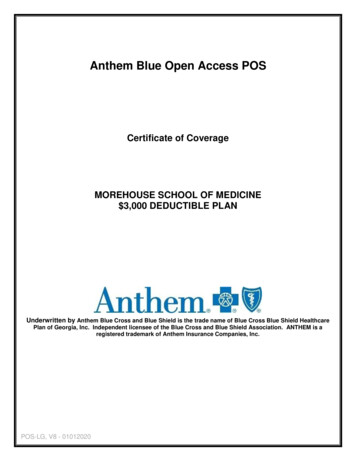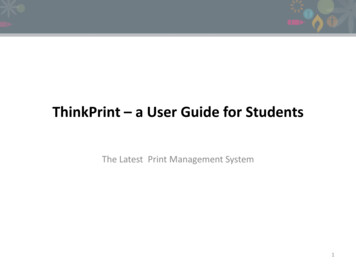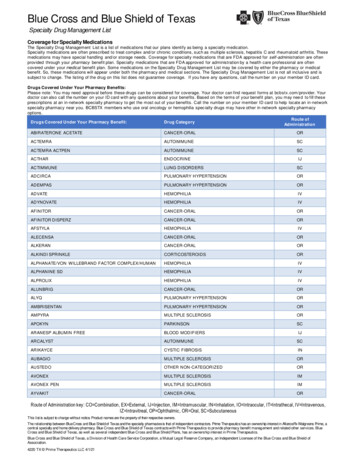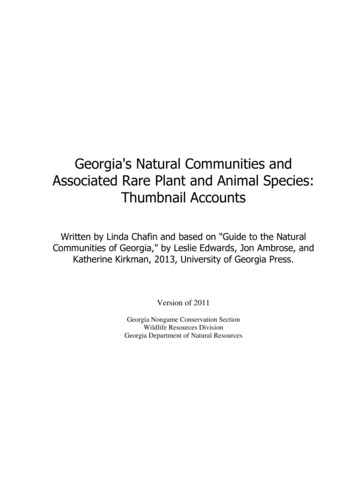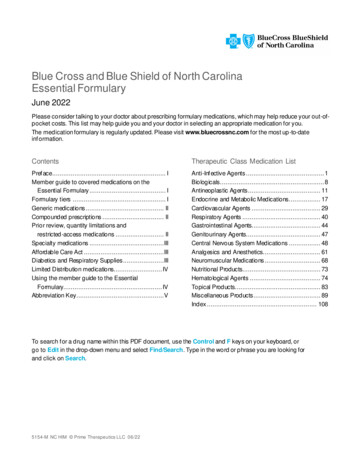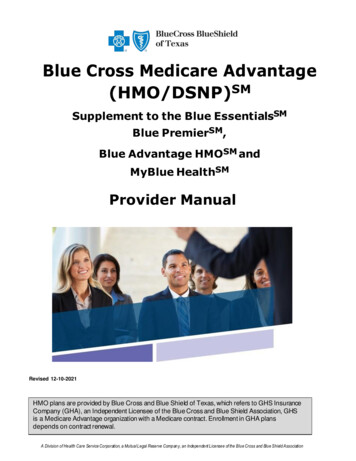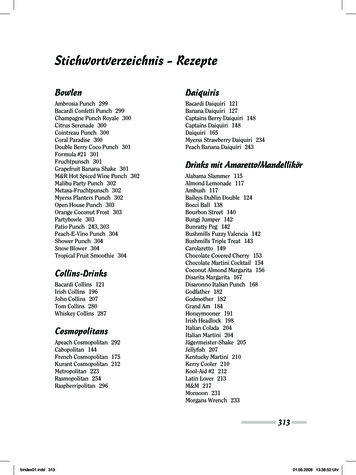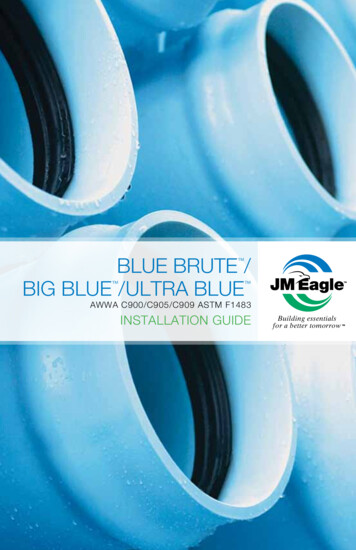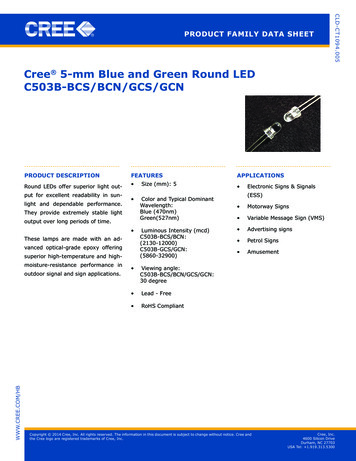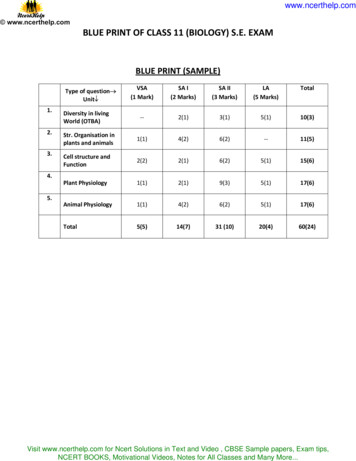
Transcription
www.ncerthelp.comBLUE PRINT OF CLASS 11 (BIOLOGY) S.E. EXAMBLUE PRINT (SAMPLE)VSA(1 Mark)SA I(2 Marks)SA II(3 Marks)LA(5 Marks)Total--2(1)3(1)5(1)10(3)Str. Organisation inplants and animals1(1)4(2)6(2)--11(5)Cell structure andFunction2(2)2(1)6(2)5(1)15(6)Plant Physiology1(1)2(1)9(3)5(1)17(6)Animal Physiology1(1)4(2)6(2)5(1)17(6)Total5(5)14(7)31 (10)20(4)60(24)Type of question Unit 1.2.3.Diversity in livingWorld (OTBA)4.5.Visit www.ncerthelp.com for Ncert Solutions in Text and Video , CBSE Sample papers, Exam tips,NCERT BOOKS, Motivational Videos, Notes for All Classes and Many More.
www.ncerthelp.comKENDRIYA VIDYALAYA SANGATHANSession Ending ExamQUESTION PAPER (SAMPLE)Class :XISubject: BiologyTime Allowed-3:30 HoursMax.Marks.:70General Instruction:(i) This question paper consists of four section A B C and D. Section a consist of 6 questions ofmark each, Section B is of 6 questions of two marks each, Section C is of 9 questions of threemarks each and section D is of 3 questions of five marks each.(ii) All questions are compulsory.(iii) There is overall choice. However, an internal choice has been provided in one question of 2marks, one question of 3 marks and three questions of 5 marks weightage.(iv) There is one additional section E of OBTA of 10 marks except 60 marks.SECTION - AQ 1.Q 2.Q 3.Q 4.Q 5.How is eukaryotic ribosomes differ from prokaryotic ribosome?What is Aestivation?What is peptide bond ? Show it by bond formation ?What is major limiting factor for photosynthesis?In which condition JG cells release renin ?SECTION – BQ 6. Why is leghaemoglobin so called ? What is its function ?Q 7. Differentiate between pulmonary and systemic circulation.Q 8. Write the floral formula of an actinomorphic, bisexual ,hypogynous flower with fiveunited Sepals, five free petals, five free stamen and two united carpels with superiorovary and exile placentation.ORDraw the structure of a maize grain and show Radical and plumule .Q 9. What is the difference between root hairs and trichomes. Mention one function of each.Q 10. Write the names of various kinds of vertebra and their number present in the vertebralcolumn of human being.Q 11. The water flow beyond cortex in roots only through symplastic pathway. Why?SECTION – CQ 12. What are the mouth parts of a cockroach? Which part among them acting as tongue?Visit www.ncerthelp.com for Ncert Solutions in Text and Video , CBSE Sample papers, Exam tips,NCERT BOOKS, Motivational Videos, Notes for All Classes and Many More.
www.ncerthelp.comQ 13. What are Nucleic acids found in living body? Differentiate Nucleotide and nucleoside.Name Nitrogenous bases which are purines and pyrimidines.ORWhat are enzymes? What is competitive inhibitor? Define Apo enzyme and coenzyme.Q 14. Who proposed fluid mosaic model of plasma membrane. Draw its structure and write anytwo functions of it.Q 15. How many molecules of carbon dioxide, ATP and NADPH are required to make onemolecule of glucose?Q 16. Name any three phytohormones. Mention their functions.Q 17. (i)Name the gland of human which acts as exocrine as well as endocrine gland.(ii)Name the hormones secreted by alpha cells and beta cells of this gland.(iii)What are the functions of these hormones?Q 18. Define osmosis and diffusion. How does plasmolysis occur?Q 19.(i) Mention A, B, C AND D in the below diagram of a neuron.(ii) What is the difference between afferent and efferent fibres of CNS?Q 20. While visiting the agriculture farm in village Tanu and Manu are confused to see that theeatable part of the potato are present underground and some roots are hanging from thestem of banyan tree. They tries to correlate their observation with their study and afterreturning back they asked the teacher to explain its reason –(a) Why underground swollen part of potato is a stem and hanging brown fibrous part ofbanyan tree are roots. Justify your answer. Give some other examples of undergroundstems & Ariel roots.SECTION – DQ.21.What is cell cycle? Draw the diagrammatic representation of cell cycle. Name the phaseof DNA synthesis.ORWrite a specific scientific term for each of the following:(i) Chromosomes are arranged on equatorial plate during mitosis.Visit www.ncerthelp.com for Ncert Solutions in Text and Video , CBSE Sample papers, Exam tips,NCERT BOOKS, Motivational Videos, Notes for All Classes and Many More.
www.ncerthelp.com(ii)(iii)(iv)(v)Disappearance of nuclear membrane during mitosisReappearance of chromosomes in mitosis .Pairing of homologous chromosomes in meiosis I.Enzyme involved in crossing over in prophase I.Q.22. (I) MentionA, B, C, D in the following cycle?Pyruvate CoA CO2ÎNADAcetyl Coenzyme A (2C)NADH H “D”“C” (4C)Citric acid (6C)NADNADMalic acid“B”(4C)GDPNADH H GTP “A” (5C)NAD – NADH H (ii) How many ATP are formed by the reduction of one molecule of FAD intoFADH2.ORWrite differences between C3 and C4plants. (Any five differences).Q.23.(i) Draw a well lebelled diagram of digestive system of human.(ii) What is the function of HCl in stomach?OR(a) What is the role of haemoglobin in transportation of Oxygen in our body?(b) What do you mean by pO2 and pCO2 ? How do they affect transport of Oxygen?Explain with Oxygen Dissociation Curve.SECTION – EQ.242 marks question from OTBAQ.253 marks question from OTBAQ.265 marks question from OTBA***Visit www.ncerthelp.com for Ncert Solutions in Text and Video , CBSE Sample papers, Exam tips,NCERT BOOKS, Motivational Videos, Notes for All Classes and Many More.
www.ncerthelp.comSESSION ENDING EXAM 2014-15BIOLOGY- XIERROR ANALYSIS (SAMPLE)Name of Student:Roll No:UnitIChapterQ.NoMarks 21221522162323751019173535521233TOTAL70Marks ObtainedTotal Marks InChapter1111131916Total Of UnitTotal Marks ObtainedSignature of ExaminerVisit www.ncerthelp.com for Ncert Solutions in Text and Video , CBSE Sample papers, Exam tips,NCERT BOOKS, Motivational Videos, Notes for All Classes and Many More.
www.ncerthelp.comS.E.EXAM (2014-15)SUBJECT- BIOLOGYCLASS-XIMARKING SCHEME (SAMPLE)SECTION – AQ 1. Erkayotic ribosome – 80 s, Prokaryotic ribosome 70 s.Q 2. Correct Definition.Q 3. The bond between carboxyl group (COOH) of one amino acid and Amino group (NH2) of anotherQ 4. CO2Q 5. A fall in glomerulaur blood/Glomenlar blood pressure/GFRSECTION – BQ 6. Leg haemoglobin resembles hemoglobin of vertebrates since it is present in root nodule ofleguminous plant. Function – oxygen seavenger and protects nitrogenase from oxygen.Q 7. Correct difference.Q 8.ORSee diagram page 77 of NCERT.Q 9. See page 89 of NCERT.Q 10. Cevicalvo 7, Thoraric V 12 , Lumber V 5, Sucral 1 fused Coccygeal (caudal) 1 fusedQ 11. Due to presence impermeable suberin layer on endodermis.SECTION – CQ 12. Page 112 of NCERT.Q 13. DNA and RNANucleotide-P S N.BNucleoside – S NBPurines- Adenine, GuaninePyrimidines- cytosine, thymine,UracilORSee page 158 of NCERT.Q 14. Page 131 of NCERT.Q 15. CO2 – 6 moleculesATP- 18 moleculesNADPH- 12 MoleculesVisit www.ncerthelp.com for Ncert Solutions in Text and Video , CBSE Sample papers, Exam tips,NCERT BOOKS, Motivational Videos, Notes for All Classes and Many More.
www.ncerthelp.comQ 16. Name and FunctionQ 17. (i) Pancreas(ii) Alpha-cell-GlucagonBeta – cell –Insulin(iii) Correct function of each.Q 18. Definition & process of plasmolysisQ 19. Page 317 & 316 of NCERTQ 20. (a) Correct justification – 3 Marks(b) 2 – 2 examples for each – 2 MarksQ 21. Page 163 of NCERTOR(I) Metaphase (ii) Prophase (iii) Anaphase (iv) zygotene (v) pachyteneQ 22. (A) α ketoglutaric acid(B) Succinic Acid(C) oxaloacetic Acid(D) NAD NADH H (ii) 2ATPORAny five differencesQ 23. Page 258 of NCERT(ii) Pepsinogen HCL Pepsin (active)provided acidic medium for the action of enzyme of Gastric juiceORLow pCO2(a) Oxygen haemoglobin ----------- OxyhaemoglobinHigh PO2(in lungs)Low pCO2Oxyhaemoglobin ----------------- haemoglobin OxygenHigh PO2(In tissues)(b) Correct explanation with Oxygen dissociation.3***Visit www.ncerthelp.com for Ncert Solutions in Text and Video , CBSE Sample papers, Exam tips,NCERT BOOKS, Motivational Videos, Notes for All Classes and Many More.
See diagram page 77 of NCERT. Q 9. See page 89 of NCERT. Q 10. Cevicalvo 7, Thoraric V 12 , Lumber V 5, Sucral 1 fused Coccygeal (caudal) 1 fused Q 11. Due to presence impermeable suberin layer on endodermis. SECTION - C Q 12. Page 112 of NCERT. Q 13. DNA and RNA Nucleotide-P S N.B Nucleoside - S NB Purines- Adenine, Guanine

